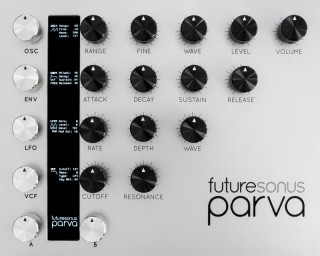Reader Geert Bevin shared this video, demonstrating playing the new Futuresonus Parva polyphonic analog synthesizer with the LinnStrument.
Note that using the LinnStrument with the Parva allows Bevin to move each note that he plays, independently of the others.
Bevin is a long-time advocate for expressive control of synthesizers. He’s the Principle Software Engineer on the Roger Linn Design LinnStrument and also the author of the Multidimensional Polyphonic Expression specification.
The Parva is a digitally-controlled analog synth module that’s both polyphonic and multi-timbral, which makes it a great candidate for playing expressively. And the latest Parva firmware patch unleashes some of this potential.
 Here’s what Bevin has to say about the video:
Here’s what Bevin has to say about the video:
As a Kickstarter backer, I’ve had the Parva for several months, but there were a few problems with the firmware that prevented me from fully using it. Today, Brad from Futuresonus released firmware update v0.51, fixing everything that was important to me.
So here is a demo video with LinnStrument.
I’ve set it up so that the x-axis controls per-note pitch and the y-axis per-note filter cutoff, I’m not using the z-axis.
The LinnStrument is connected directly to the Parva’s USB MIDI host port, which also provides power. The audio is recorded through my Metric Halo ULN-8 audio interface without any sound processing besides normalisation.
The Parva has eight independent analog voices that can be configured in a multi with a dedicated MIDI channel for each voice. Each voice can play a different preset, but I’m using the same preset for all voices here to allow for per-note expression.
In this multi, each MIDI channel is also sent to two voices, creating a unison sound, while still having full control over 4 independent notes.
I think it sounds pretty great!
Pricing and Availability
The Futuresonus Parva is available for to pre-order for US $999. The LinnStrument is available via Roger Linn Designer and their retailers for a street price of about US $1,500.

Nice work Geert!
Sounds great!
From Modal to Futuresonus to even Behringer, their offerings interest me far more than anything DSI, Moog or even any of the eurorack makers as they are making new instruments with a nod to the best aspects of past. From the user interface to the actual instruments, these manufacsturers are trying to push progress not simply the art form yet the technology as well. I even applaud Roland for refusing the reach back to move forward as Korg has with the ARP series and the MS20.
this vid makes me want both
999usd though, is that a bit expensive? you rather have this or a deepmind.
The DeepMInd 12 looks like it may be a great synth, but Behringer has not made any mention of multitimbral operation or MPE support – which are required for the type of performance this video demonstrates.
Also the parva and deep mind have the same number of oscillators (24) but the parva organized them into *3* per voice, which is much more expressive, not to mention a large number of LFOs and envelopes. And the parva has a developer who personally responds to email and makes changes as requested. A lot of personal touch you’ll NEVER get with Behtrnger. And the build quality appears to be much better. The only things the Deep Mind has going for it are its add-ons: effects, keyboard, arpeggiator/step sequencer. Of course those things may be pretty significant to you. Or not. I’d easily pick the Parva over the DeepMind.
Me wanna Parva!
Best feature of the Parva synth? It has a USB master port which means you can hook up a usb controller directly without a computer or interface.
This should have been the new standard when makers decided to abandon traditional midi ports.
Am I to suspect I could plug in a roli seaboard via USB and jam with MPE support?
You can indeed